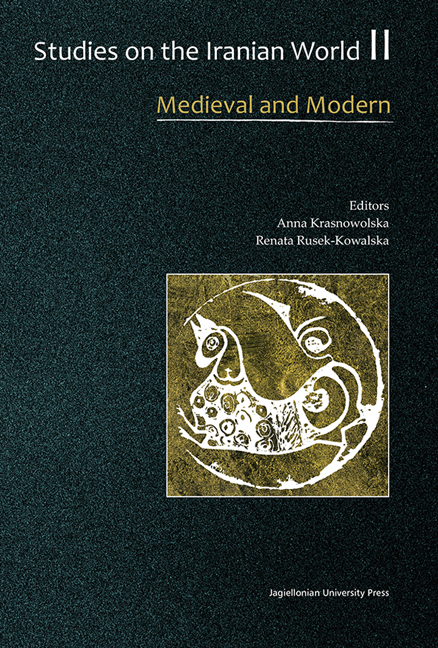Book contents
- Frontmatter
- Contents
- Foreword
- Linguistics
- Literature
- Religion
- Shibboleths of Heresies: on Some Essential Markers of the Near Eastern Non-Dogmatic Milieu
- Female Religious Practitioners in the Context of Contemporary Transformations of Islam in Tajikistan
- The Key Content of Contemporary Zoroastrian Identity in the Islamic Republic of Iran: a Socio-Anthropological Approach
- History
- Arts
- Social and Cultural Studies
Shibboleths of Heresies: on Some Essential Markers of the Near Eastern Non-Dogmatic Milieu
from Religion
Published online by Cambridge University Press: 12 January 2018
- Frontmatter
- Contents
- Foreword
- Linguistics
- Literature
- Religion
- Shibboleths of Heresies: on Some Essential Markers of the Near Eastern Non-Dogmatic Milieu
- Female Religious Practitioners in the Context of Contemporary Transformations of Islam in Tajikistan
- The Key Content of Contemporary Zoroastrian Identity in the Islamic Republic of Iran: a Socio-Anthropological Approach
- History
- Arts
- Social and Cultural Studies
Summary
SUMMARY
The comparative study of heterodox Islam and its derivatives (in particular, Yezidism), reveals multiple parallels easily explained either by the common Muslim origin or popular regional traditions. Some of those striking similarities, however, occur in the religious systems separated from each other by time and geography, and thus cannot only be determined by religious developments of certain historical periods in specified areas. This paper focuses on several religious phenomena marking quite different heterodox traditions of the region, particularly on the figure of Malak Tāwūs, the worship of the black dog, and the tanāsux (reincarnation). Some of these elements still exist among the Yezidis and the Ahl-i Haqq, and some, whose relics are observed on a marginal level, can be reconstructed through comparative historical analysis. The research is both a statement of the problem, that of shibboleths marking non-dogmatic groups of the Near Eastern region, and an attempt of comparative analysis of these markers.
Non-dogmatic groups in the Near Eastern region share a number of common elements, which can hardly be determined either by their mutual influence or by similar religious developments of certain historical period in a given area.
If, for instance, the parallels between the Yezidism and extreme Shi‘a sects (ghulāt), rooted in the same heterodox Muslim environment, have been previously emphasized,1 a wider analysis of this phenomenon as part of the whole Near Eastern non-dogmatic, and particularly pre-Islamic milieu, still remains a challenge for scholars of comparative religion studies.
Revealed on different levels – being among either fundamentals of nondogmatic traditions or their marginal elements – such common elements can be generally defined as specific, distinctive markers, or shibboleths of the Near Eastern ‘heretic’ milieu, but not only that of the heterodox Islam. Having existed in the area long before the emergence of Islam, they most probably penetrated into the heterodox Muslim milieu and have been preserved as its marginal constituents in sectarian trends.
The paper focuses on the following three phenomena – the cult of Malak- Tāwūs (Peacock Angel),3 the worship of the black dog, and the idea of tanāsux (reincarnation), since they mark quite different traditions, having emerged in different periods of time and going back to different religious environments.
The figure of Malak-Tawus reigns in the Yezidi religious mentalité, the Peacock Angel being the basic characteristic of the Yezidi religion and the essence of their faith.
- Type
- Chapter
- Information
- Studies on the Iranian WorldMedieval and Modern, pp. 119 - 128Publisher: Jagiellonian University PressPrint publication year: 2015



